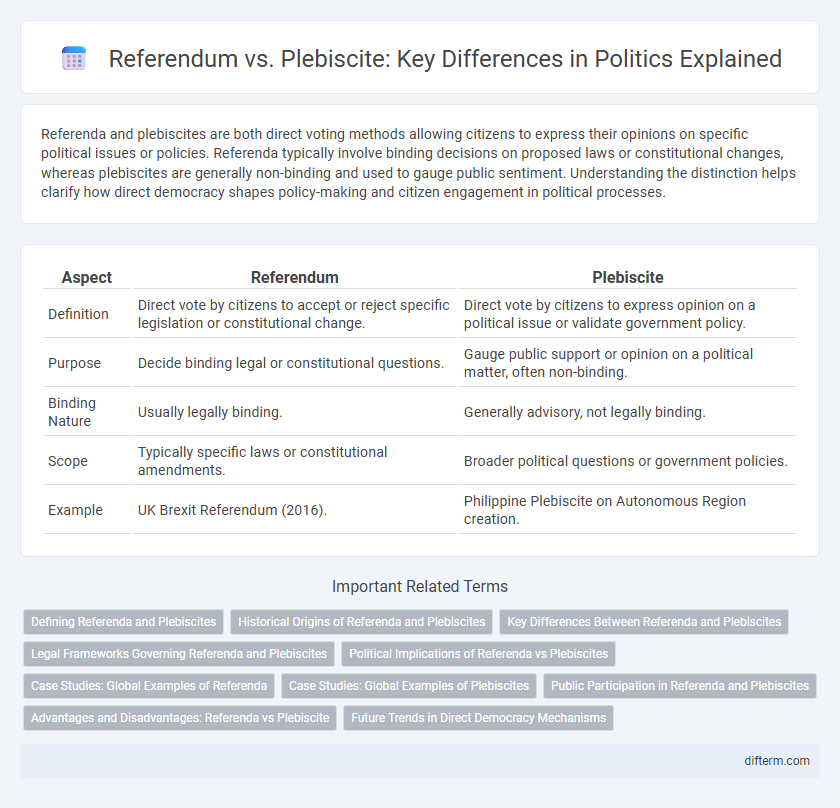Referenda and plebiscites are both direct voting methods allowing citizens to express their opinions on specific political issues or policies. Referenda typically involve binding decisions on proposed laws or constitutional changes, whereas plebiscites are generally non-binding and used to gauge public sentiment. Understanding the distinction helps clarify how direct democracy shapes policy-making and citizen engagement in political processes.
Table of Comparison
| Aspect | Referendum | Plebiscite |
|---|---|---|
| Definition | Direct vote by citizens to accept or reject specific legislation or constitutional change. | Direct vote by citizens to express opinion on a political issue or validate government policy. |
| Purpose | Decide binding legal or constitutional questions. | Gauge public support or opinion on a political matter, often non-binding. |
| Binding Nature | Usually legally binding. | Generally advisory, not legally binding. |
| Scope | Typically specific laws or constitutional amendments. | Broader political questions or government policies. |
| Example | UK Brexit Referendum (2016). | Philippine Plebiscite on Autonomous Region creation. |
Defining Referenda and Plebiscites
Referenda are binding votes by the electorate on specific legislative issues or constitutional amendments, directly influencing lawmaking and government policy. Plebiscites typically serve as non-binding votes that measure public opinion on important national or political questions without mandating government action. Both mechanisms enable direct democracy by involving citizens in decision-making, but referenda possess legal authority, while plebiscites primarily guide policymakers.
Historical Origins of Referenda and Plebiscites
Referenda and plebiscites both trace their origins to ancient democratic practices, with referenda rooted in Roman law where citizens directly voted on laws, and plebiscites originating as decisions made by Roman assemblies under the authority of leaders. The modern distinction emerged during the 19th century in Europe, as referenda evolved into mechanisms for legislative approval while plebiscites were used to gauge public opinion on sovereignty or constitutional matters. Understanding these historical origins reveals how referenda serve as tools for direct democracy, whereas plebiscites often function as political instruments to legitimize leadership or territorial changes.
Key Differences Between Referenda and Plebiscites
Referenda and plebiscites both involve direct voting by the electorate, but referenda typically address specific legislative or constitutional changes requiring binding decisions, while plebiscites are often consultative, seeking public opinion without mandatory legal effect. Referenda are usually initiated by government bodies or legislative authorities to enact or reject formal legal measures, whereas plebiscites may be organized to gauge public sentiment on broader policy issues. The legal binding nature and the scope of issues covered constitute the primary distinctions in political processes between these two forms of direct democracy.
Legal Frameworks Governing Referenda and Plebiscites
Referenda and plebiscites are governed by distinct legal frameworks that define their scope, authority, and procedural requirements within political systems. Referenda typically require specific legislative enabling acts or constitutional provisions outlining voter eligibility, question formulation, and binding outcomes, while plebiscites often serve as advisory votes with more flexible regulations. Understanding these legal parameters is crucial for interpreting the legitimacy and impact of direct democratic processes in governance.
Political Implications of Referenda vs Plebiscites
Referenda typically involve direct voting on specific legislation or constitutional changes, granting citizens a formal mechanism to influence policy decisions and potentially shift power dynamics within a political system. Plebiscites often serve as a tool for governments to gauge public opinion on broader political issues or legitimacy, sometimes used to consolidate authority or validate leadership without binding outcomes. The political implications of referenda tend to underscore democratic participation and policy legitimacy, whereas plebiscites may reflect strategic political maneuvers and questions of governance stability.
Case Studies: Global Examples of Referenda
Referenda serve as direct democratic tools allowing citizens to vote on specific legislative or constitutional issues, evidenced by the 2016 UK Brexit referendum where over 72% turnout resulted in a decision to leave the European Union. In contrast, plebiscites often function as advisory votes on government policies without binding outcomes, as seen in Australia's 1999 republic plebiscite which failed to pass despite significant public engagement. Global case studies highlight the efficacy of referenda in enshrining major systemic changes, while plebiscites typically influence political discourse without enforcing immediate legal alterations.
Case Studies: Global Examples of Plebiscites
Plebiscites have been employed worldwide as direct democratic tools to resolve pivotal political issues, exemplified by the 2016 Brexit vote in the United Kingdom, where citizens decided on EU membership. Another notable case is the 1995 Quebec referendum in Canada, addressing sovereignty and national identity. These global examples demonstrate plebiscites' role in shaping governmental policies and national boundaries through popular mandate.
Public Participation in Referenda and Plebiscites
Referenda and plebiscites both serve as instruments of direct democracy, enabling citizens to vote on specific issues or policies. Public participation in referenda typically involves binding decisions on constitutional or legislative matters, ensuring that voter outcomes carry legal authority. Plebiscites, often advisory, engage the public to gauge opinion without requiring government action, fostering political awareness and inclusivity.
Advantages and Disadvantages: Referenda vs Plebiscite
Referenda empower citizens to directly decide on specific legislative or constitutional issues, enhancing democratic participation but sometimes oversimplifying complex policies. Plebiscites serve as consultative tools that gauge public opinion on broader political questions, offering flexibility but lacking binding authority and potentially causing political ambiguity. Both mechanisms face challenges such as low voter turnout and manipulation risks, yet referenda provide clear legal outcomes while plebiscites support advisory decision-making.
Future Trends in Direct Democracy Mechanisms
Future trends in direct democracy mechanisms indicate a growing preference for referenda over plebiscites due to their binding nature and clearer legal frameworks. Technological advancements like blockchain voting and online platforms are expected to enhance transparency, security, and accessibility in referenda processes worldwide. Governments increasingly explore hybrid models that combine representative democracy with direct democratic tools to engage citizens more effectively in policymaking.
referenda vs plebiscite Infographic

 difterm.com
difterm.com